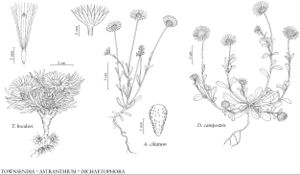Townsendia hookeri
Contr. Gray Herb. 183: 95, plates 17, 20, figs. 5, 6. 1957.
Perennials, 1–3 cm (± pulvinate). Stems ± erect; internodes 0.1–1 mm, ± strigose. Leaves basal and cauline, blades narrowly oblanceolate to linear, 5–25(–40+) × 1–1.5(–3) mm, fleshy, faces ± strigoso-sericeous, little, if at all. Heads ± sessile. Involucres ± campanulate, 8–18+ mm diam. Phyllaries 50–65+ in 5+ series, the longer ± lance-linear, 7–11(–13) mm (l/w = 6–9), apices attenuate, abaxial faces sparsely strigose or glabrate. Ray florets 15–35; corollas white adaxially, laminae 8–12+ mm, glabrous abaxially. Disc florets 120–180+; corollas 4–5(–6+) mm. Cypselae 3.5–4.5 mm, faces hairy, hair tips glochidiform; pappi persistent; on ray cypselae ca. 30 subulate to setiform scales (1–)5–7 mm; on disc cypselae ca. 30 subulate to setiform scales 5.5–7.5+ mm. 2n = 18.
Phenology: Flowering Mar–Jun.
Habitat: Gravelly benches, sandy slopes
Elevation: 700–1800 m
Distribution

Alta., B.C., Sask., Yukon, Alaska, Colo., Idaho, Mont., Nebr., N.Dak., S.Dak., Utah, Wyo.
Discussion
Selected References
None.
